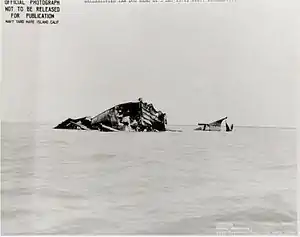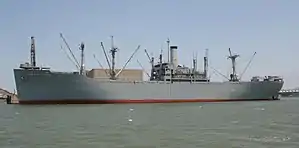SS Quinault Victory
The SS Quinault Victory was the thirty-first Victory ship built by Oregon Shipbuilding Corporation in Portland, Oregon under the auspices of the Emergency Shipbuilding Program in support of America's involvement in World War II. Laid-down on 3 May 1944 and launched on 17 June (sponsored by Mrs. Carroll McQueen, with Mrs. A.T. Eaton and Mrs. Walter A. Sovey as Matrons of Honor and Ruth Burgwald serving as flower girl[1]), Quinault Victory was delivered to the War Shipping Administration and subsequently leased to the United States Lines Company.
 SS Quinault Victory 18 July 1944 | |
| History | |
|---|---|
| Name: | SS Quinault Victory |
| Namesake: | Quinault, Washington |
| Owner: | War Shipping Administration |
| Operator: | United States Lines Company |
| Builder: | Oregon Shipbuilding Corporation, Portland OR |
| Laid down: | 3 May 1944 |
| Launched: | 17 June 1944 |
| In service: | 11 July 1944 |
| Out of service: | 17 July 1944 |
| Fate: | Exploded & sank 17 July 1944 Port Chicago, CA USA |
| General characteristics | |
| Class and type: | Victory Ship VC2-S-AP3 |
| Displacement: | 7,608 gross tons, deadweight 12,000 tons |
| Length: | 439 ft (150 m) |
| Beam: | 62 ft (21.2 m) |
| Draft: | 28 ft 6 in (8.1 m) |
| Propulsion: | Westinghouse DR geared turbine, 2 x single screwed shaft horsepower 8,500 |
| Speed: | 16.5 knots |
| Complement: | 36 Merchant Marine and 17 US Naval Armed Guards |
| Armament: | |
| Notes: | MC Hull No. 115 |
Port Chicago, California
On July 11, 1944 Quinault Victory sailed from Portland, under the command of Merchant Marine Captain Robert J. Sullivan arriving at the Shell Oil Company's Martinez, California refinery on July 17, 1944 where she took on a partial load of fuel oil. Some of the oil taken aboard was of a type that released light hydrocarbon gas on agitation, heating, or standing. This could have resulted in formation of an explosive mixture in the confined air space above the oil in the tanks. Prior to being sent to Martinez for a pre-loading inspection was made by the Port Director's officers and the Captain of the Port's office, and no defects were noted.

Upon leaving Martinez she sailed up Suisun Bay to Port Chicago Naval Magazine, California arriving approximately 6:00 PM (Pacific War Time) in preparation for her maiden voyage. Some difficulty was experienced in mooring her due to winds and tides. She was moored on the starboard side headed east at the outboard berth across from the SS E.A. Bryan, a Liberty ship. Upon arrival at Port Chicago, California both the loading officer and his assistants visited the ship, gave copies of pertinent magazine orders to the master, inspected some of the holds and saw that the ship was being properly rigged for loading. The number 5 cargo hold was not being rigged, as it was not to be loaded that night. As a new ship, this was the first time the Quinault Victory had been rigged for loading. Trouble was experienced with shackles and preventer guys as they were non-standard. Winding on some of the winches were on backwards and had to be corrected. Loading normally have started at midnight. Dunnage ammunition and loaded railcars were parked on the pier for loading to the ships. The railcars slated for Quinault Victory contained 253 tons of bombs and 5 inch projectiles for 5"/25 caliber guns. Across the pier the E.A. Bryan was already loaded with 6,064 tons of ammunition and had an additional 176 tons on the pier, including 60 tons of incendiary clusters, to be loaded before departing.
Port Chicago disaster
On July 17, 1944, at 10:18 PM local time, two major explosions occurred 6 seconds apart in what became known as the Port Chicago disaster. The detonation of 4,600 tons of munitions being loaded onto the Quinault Victory and E.A. Bryan, registered at a magnitude of 3.4 on the seismograph at the University of California, Berkeley, some 20 miles away. The force of the explosions lifted the Quinault Victory out of the water, and she landed 500 feet away upside-down and facing the opposite direction. The E.A. Bryan was essentially vaporized, as there were no identifiable remains of her following the explosions. 320 sailors and dockworkers were killed and 390 were injured, making it the worst U.S. home front disaster of World War II.
The span of only twelve weeks between the ship's keel being laid and the disaster may make Quinault Victory the most short-lived of all the Victory ships.
Ship’s complement
Mariners killed:
- Deck Department:
- Carpenter: Roy L. Nelson
- Deck Maintenance: Hugh E. Crawford
- Licensed: Robert E. Keim (2nd Mate), Kenneth M. Moen (Jr. 3rd Mate), David R. Parsons (3rd Mate), Albert R. Scott (Chief Mate)
- Seamen - Able Bodied: John D. Bell, Wallace M. Durland, Kenneth J. Eulrich, Robert K. Hendrickson, Joseph B. Koeninger, Howard W. Sullivan.
- Seamen – Ordinary: Floyd F. Crist, Lloyd K. McDaniel, Isadore E. Narinsky, Lester S. Skance.
- Engineering Department: Donald H. Cheney (Electrician), Ellis Hendricks (Night Engineer), Eugene W. Garrett (Fire Watch), Walter Frederick Kanneberg (Kennberg) (3rd Engineer), Earl L. Mallery (1st Engineer), Ellis B. Pinson (Jr. 3rd Engineer) Earl L. Mallery (1st Engineer), Robert E. Morell (Oiler), Virgil R. Sandberg (2nd Engineer), Glen E. Thompson (Jr. Engineer)
- Senior Personal: Robert J. Sullivan (Master), John A. Williams (Chief Engineer)
- Steward's Department:
- Messmen: Robert D. Bailey, Robert E. Bartlett, Albert G. Diede, Burke Elmo Falor, Lewis J. Widnoe
- Purser: John D. Bell
- Steward: Johannes N. Justesen
Naval Armed Guards killed:
- Gunner's Mates 2nd Class: Delbert P. Bergstrom, William H. Mulryan
- Gunner's Mates 3rd Class: Jack L. Albin, John Gibson Hall
- Seamen 1st Class: Jack P. Bowman, George D. Hovland, Andy Morrow, Henry J. Myers, Woodrow Arthur Riiff, Jacob D. Risenhoover, William R. Robinson, Charles H. Roedell (Rondell), Charles H. Rose, Jr., Otis Kyle Ross, Woodrow W. Saint, Arnold T. Sanders, Harold S. Sang (Sano)
Mariners injured:
- Steward's Department:
- Messmen: Juan B. Gaggucas, Frank Sullivan
- Engineering Department: Robert F. Strobel (Maintenance Engineer)[3]
The names of those killed aboard Quinault Victory are listed at the Port Chicago Naval Magazine National Memorial which was dedicated in 1994.

See also
- Liberty ship = Previous cargo ship.
- List of Victory ships
- Type C1 ship
- Type C2 ship
- Type C3 ship
References
- Oregon Journal June 19, 1944 final edition.
- "Port Chicago Disaster". Retrieved 1 August 2016.